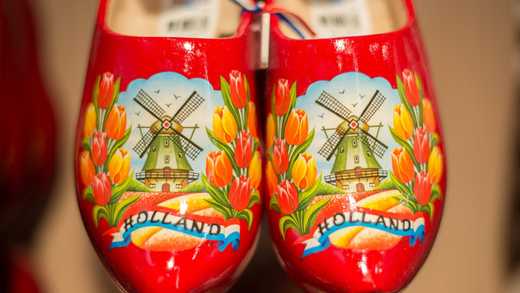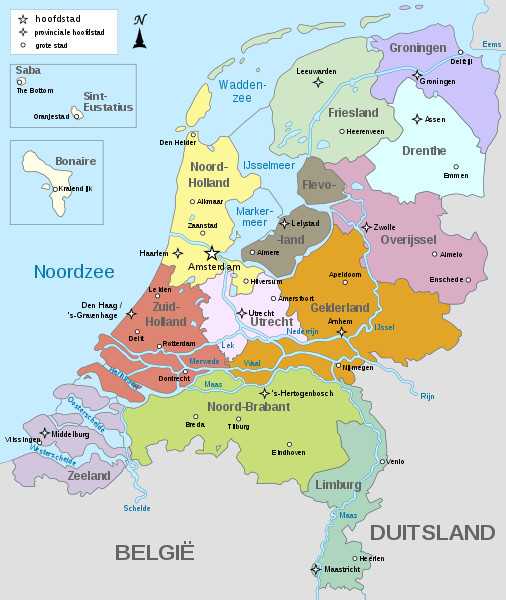Dutch Dialects: How To Tell Them Apart (Main Differences)
 Written byFergus O'Sullivan
Written byFergus O'Sullivan- Read time10 mins
- Comments0

If you’ve decided to learn Dutch, you’ve probably already found out one major issue: the people on the tapes and in the videos sound absolutely nothing like the people you’re talking to in shops, bars or your office.
This is because the actors in materials or the teacher of your course are speaking something called **Standaardnederlands **(standard Dutch). You may know it as ABN, though that term is going out of use.
Standard Dutch is great because it’s pronunciation is clear and more or less follows the way Dutch is written.
It’s not so great because, well, almost nobody talks like that.
Even the most educated Dutch people break some of the rules of standard Dutch.
In this article, I’ll go over some of the main differences between standard Dutch and spoken Dutch that will hopefully make it easier for you to understand what people are saying and help you get to proficiency with Dutch a little bit quicker.
Make sure to check out our detailed list of the best online Dutch courses too.
How many Dutch dialects are there?
There are over 200 dialects of the Dutch language in the Netherlands — we’re not counting Belgium for this article as the number would double.
Not all these 200 dialects can understand each other equally clearly.
For example, I grew up in Haarlem, near Amsterdam, which is reputed to be the place that speaks something closest to standard Dutch.
However, in my neighborhood we speak “plat” (flat), or dialect, and that’s how I spoke growing up. When I moved to Amsterdam in my twenties, I took on that accent and dialect and now I speak a mix of the two.
When I go to parts of the south and east of the country, I don’t understand everybody on the first try, and they don’t always understand me, either.
Kinds of Dutch dialects
Roughly speaking there are five groups of Dutch dialects, each of which will have a bunch of subgroups. You can more or less divide them by provinces.

- Hollands, which is spoken in the provinces of North and South Holland, as well as parts of Utrecht; most language learners will likely get into contact with this one as it’s what’s spoken in the Randstad plus some of the rural areas around it.
- Zeeuws, the dialect of Zeeland, one of the smallest provinces, south of Rotterdam. We won’t cover it in much detail here as there’s not that many that speak it.
- Brabants, which is spoken, unsurprisingly, by people in and from Brabant. It has some different pronunciation and its own vocabulary.
- Limburgs, which is a dialect that is close to being declared its own language thanks to how different it is. It’s spoken in, you guessed it, Limburg.
- The last group is spoken in the west and north of the country and is only bundled by linguists, who call it Nedersaksisch. Everybody else will call it eastern or northern, or name it by province (Drents, Gronings, etc.).
There is also another language spoken in the Netherlands, in the province of Friesland. It’s called Frisian and is only partially intelligible with Dutch.
People from there have a distinct accent as around 40 percent of them speak Frisian at home. Despite many of them having Dutch as a second language, though, you’ll never run into issues speaking Dutch in Friesland, and their accent isn’t too tricky, though they will drop Frisian words into conversation occasionally.
Here’s an example of Frisian.
Telling the difference between Dutch dialects
Going over all these groups in detail would take a book (this book, for one example), so we’ll just go over the biggest differences here.
We’ll also briefly lift out one city dialect language learners are bound to come into contact with, that of Amsterdam.
Brabants and Limburgs: The soft G
The first big difference in Dutch is that between the two ways to pronounce the letter G (or CH).
You probably already know that in Dutch, G is pronounced from the throat and makes a rough scraping sound, like the J in Castilian Spanish.
However, that sound is only pronounced that way in the northern Netherlands.
The southern Netherlands — pretty much Brabant and Limburg but linguistically going all the way into Flanders — the G is pronounced much softer, more like the second G in the U.S, pronunciation of “garage” or the French G.
Generally speaking, if you’re talking to somebody and they pronounce the Dutch G a little softer, they’re from below the rivers, so from Brabant or Limburg.
There are a few exceptions, some towns on the rivers will have a soft G while some parts of Brabant still have pretty hard Gs.
Still, though, it’s a pretty good rule of thumb and will help you place people a little easier. That said, Dutch people can switch between the two, so Brabanders who have lived in Amsterdam for a few years probably have a hard G, and vice versa.
Other differences
It’s not just the G sounds that sets Brabant and Limburg apart from the rest of the Netherlands.
Each province has its own distinct dialect, and there’s plenty of differences within those areas as well. Limburgs is considered a different language by some linguists.
The vocabulary, especially that of rural districts and small towns, can differ so much from standard Dutch that it can be a bit hard to understand if you’re not from there.
However, if you just want to figure out where somebody is from, it’s best to listen: all consonants are pronounced a little softer in these two provinces, not just the G, and the vowels are a little more drawn out.
Here’s a great example of Helmonds, a city in Brabant, that illustrates these differences.
And here’s another of Limburgs that really shows how different the vocabulary is.
Hollands
From the soft G, we’ll now go to the hardest G the Netherlands has: Holland, especially in the big cities like Amsterdam, Rotterdam, The Hague and Utrecht — okay, that one isn’t in Holland, but falls under the same dialect.
The dialects of the Randstad, the ring of cities in the west that form the biggest concentration of population in the Netherlands, is unmistakable.
It’s also the dialect that’s best understood by all Dutch people: if you speak it, other Dutch speakers can usually understand you better than you can them; just something to keep in mind.
Chances are, they’re also the dialects you’re most likely to come across as a language learner as most readers will likely be living in the Randstad.
Standard Dutch
Standard Dutch may be the marker for what is “proper” Dutch, but it’s clearly based on a Holland dialect.
The** G is hard**, and the closest you can get to its naturally spoken form is in the area around Haarlem, though not everybody there speaks that way, myself being one example.
That aside, standard Dutch has a few quirks you need to understand before you can understand what makes dialects so different.
For one, it actually pronounces all the letters in a word, and pronounces all the words more a lot more clearly, in the front of the mouth.
A word like “to run,” is pronounced “rennen,” exactly as it’s spelled.
Besides pronunciation ,standard Dutch speakers also pride themselves on using proper grammar, which can be an issue for everybody else.
What sets the Holland dialect apart
Generally speaking, the Holland dialect leaves grammar alone, though you will often hear people conjugate the word “to want” irregularly instead of regularly.
The proper way is to shift willen into the past tense by changing it to wilde. but many people in Holland (and some parts outside of it) will instead change it to wou (sounds like “wow”), which is an archaic form.
Other than that, many of the differences you’ll notice as a learner is that in Holland, the **final N **on verbs and in the plural of nouns is dropped.
For example, the verb rennen will be pronounced either “renne” (in North Holland) or like “rennuh” (in South Holland).
Much the same goes for nouns that have a plural with -EN.
Another big difference, and a relatively modern one, is that more and more people are “flattening” the IJ/EI diphthong, from the classic sound, to something a lot more like AI.
This turns a word like blijven (to stay) into “blaiven.” Though it’s not as drastic as written, it’s a noticeable difference.
What makes Amsterdam weird
Of course, if you’ve ever heard somebody from the working class of Amsterdam speak, you’ll quickly realize that it breaks a lot more rules than the standard Holland dialect does.
This is because it has a lot of influences from not just the surrounding area, but also from the **southern Netherlands and Flanders **thanks to migrants moving north over the past few centuries.
Another factor was the large Jewish population the city had until WWII, which brought many Yiddish and Hebrew words into the dialect.
Though most of that population was murdered by the Germans, their legacy remains in words like mazzel (luck, also used as a way to say goodbye) and kapsones (arrogance).
Another huge difference is in the way Amsterdammers pronounce Z, which is turned into a hard S, and a really hard one, too.
Oddly enough though, these days this dialect is found more in Almere and Lelystad, a result of much of the city’s working class moving to greener pastures.
To get a taste of what Amsterdams sounds like, there’s a very famous rap song by the group Osdorp Posse that summarizes it nicely.
Eastern and Northern dialects
We’ll finish up by going over the dialects spoken in the east and north of the Netherlands.
These dialects are again very diverse, most native speakers can hear the difference between people from Gelderland, Drenthe and Groningen just fine, but for learners it’s likely it’ll blur together a lot.
Generally speaking, the differences in vocabulary aren’t too huge with standard Dutch, and you can usually figure out any unknown words pretty easily.
The pronunciation can be very different, though.
One big difference is the tendency for people to drop the E inside EN at the end of words. So rennen becomes “renn’n.”
On top of that, in many variants the IJ turns into IE, so kijken (to look) becomes “kiek’n.”
The below video goes into the details of probably one of the toughest dialects of the region, spoken in the** Achterhoek**, in the east of Gelderland.
If you’re used to standard Dutch, you might find that the people in the video sound like they’re mumbling a little.
This is typical for more rural areas. For example, people that live in a city like Groningen will speak a lot clearer, yet maintain many of the characteristics of the overarching dialect.
Here’s one example:
The Dutch dialects are diverse
For such a tiny country, Dutch has a huge amount of different dialects and accents, and there’s no way such a short article can do them all justice.
That said, I hope that this article helps you understand why the people you meet every day speak differently than the actors in your courses do.
One final tip: if you ever want to learn your local dialect, just ask. Though many Dutch people find the rules of standard Dutch annoying, they’re more than happy to share their own dialect or regional language.
For fun, also see our guide on Dutch idioms.
 Grab the link to this article
Grab the link to this article